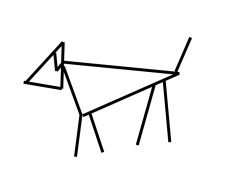Welcome to a new blog series – the dog commandments. I’m going to talk about the ultimate commands for a happy and safe life with your dog. They’re easy to teach your dog and should form the basis for ongoing training. We are going to start with something simple and wonderfully adaptable – “wait”.
Why it’s useful
I think this is one of the most useful commands a dog can know because it gives you (aka the almighty dog master) control over precious, precious resources. And resources in the dog world are pretty basic; things like food, water, going for a walk and being allowed to get on the couch. By teaching wait, you can teach your dog that he needs your permission to use or keep using any of said resources. When linked with a “release” word, it allows you to tell your dog “don’t do anything until I say the special word” and “special word!”.
Examples of how to use it
This is easily Atlas’s most well followed command because we use it 10-20 times on a daily basis. There are food related waits (before being served dinner, before being allowed to accept a treat), which are great because the reward for waiting is getting the food! There are also walking waits – we ask him to wait at the kerb, as well as the front door before leaving the house. We have also trained him to respond to wait even if we aren’t stopping at a particular place – he will stop mid stride and stand there if we call “wait”. It’s also useful for things like grooming, vet visits, standing on scales and accepting pats from inquisitive kids (I use it like the more traditional “stand” command taught in most obedience schools).
How to teach it
Believe it or not, “wait” is incredibly easy to teach – your dog can pick it up across all the above examples in a matter of days. If you want your dog to wait to tuck into their food or a treat:
- Put their bowl or treat on the floor in front of them
- Stand in front of them and hold their collar
- Raise a hand with your palm flat in front of their face and say “wait” (or whatever command word you want)
- When they are calm and not moving, release their collar and say “ok” (or whatever release word you want)
Each time you do this, try and have less and less hold on their collar – you can progress to a finger just resting on the collar, with the final goal being no hand on their collar at all. To take it further, have your dog “wait” several seconds before saying your release word.
To teach your dog to wait at the kerb or stand still even with an open door/gate in front of them, try this:
- With your dog on lead, approach a kerb or a door
- When you stop, say “wait” and move your hand in a swiping motion above your dog’s eyes
- When they are calm and not moving, reward profusely
- When you want to keep moving, say “ok” so they know they are allowed to continue with you
Don’t worry if your dog pulls on the leash, crazily trying to keep moving while you are standing still. Be firm and consistent and don’t budge an inch. They will soon learn that a) the fastest way to get moving is to stop when you ask and b) that they get treats just for standing still!
Once your dog is nicely waiting at landmarks like kerbs, ask them to wait at a random spot (e.g. when you need to bag a poop they just lovingly produced for you) and reward them when they do.
Here’s a short vid of Atlas demonstrating expert level waiting!
Practice every day and you’ll have it mastered in no time!
Happy training and much love,

